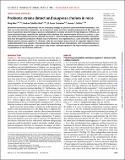| dc.contributor.author | Mao, Ning | |
| dc.contributor.author | Cubillos, Andres Fernando | |
| dc.contributor.author | Cameron, Douglas | |
| dc.contributor.author | Collins, James J. | |
| dc.date.accessioned | 2018-08-27T19:54:40Z | |
| dc.date.available | 2018-08-27T19:54:40Z | |
| dc.date.issued | 2018-05 | |
| dc.date.submitted | 2017-06 | |
| dc.identifier.issn | 1946-6234 | |
| dc.identifier.issn | 1946-6242 | |
| dc.identifier.uri | http://hdl.handle.net/1721.1/117566 | |
| dc.description.abstract | Microbiota-modulating interventions are an emerging strategy to promote gastrointestinal homeostasis. Yet, their use in the detection, prevention, and treatment of acute infections remains underexplored. We report the basis of a probiotic-based strategy to promote colonization resistance and point-of-need diagnosis of cholera, an acute diarrheal disease caused by the pathogen Vibrio cholerae. Oral administration of Lactococcus lactis, a common dietary fermentative bacterium, reduced intestinal V. cholerae burden and improved survival in infected infant mice through the production of lactic acid. Furthermore, we engineered an L. lactis strain that specifically detects quorum-sensing signals of V. cholerae in the gut and triggers expression of an enzymatic reporter that is readily detected in fecal samples. We postulate that preventive dietary interventions with fermented foods containing natural and engineered L. lactis strains may hinder cholera progression and improve disease surveillance in populations at risk of cholera outbreaks. | en_US |
| dc.publisher | American Association for the Advancement of Science (AAAS) | en_US |
| dc.relation.isversionof | http://dx.doi.org/10.1126/scitranslmed.aao2586 | en_US |
| dc.rights | Creative Commons Attribution 4.0 International License | en_US |
| dc.rights.uri | http://creativecommons.org/licenses/by/4.0/ | en_US |
| dc.source | Science Translational Medicine | en_US |
| dc.title | Probiotic strains detect and suppress cholera in mice | en_US |
| dc.type | Article | en_US |
| dc.identifier.citation | Mao, Ning et al “Probiotic Strains Detect and Suppress Cholera in Mice.” Science Translational Medicine 10, 445 (June 2018): eaao2586 © 2018 The Authors | en_US |
| dc.contributor.department | Institute for Medical Engineering and Science | en_US |
| dc.contributor.department | Massachusetts Institute of Technology. Department of Biological Engineering | en_US |
| dc.contributor.mitauthor | Mao, Ning | |
| dc.contributor.mitauthor | Cubillos, Andres Fernando | |
| dc.contributor.mitauthor | Cameron, Douglas | |
| dc.contributor.mitauthor | Collins, James J. | |
| dc.relation.journal | Science Translational Medicine | en_US |
| dc.eprint.version | Final published version | en_US |
| dc.type.uri | http://purl.org/eprint/type/JournalArticle | en_US |
| eprint.status | http://purl.org/eprint/status/PeerReviewed | en_US |
| dc.date.updated | 2018-08-27T17:33:10Z | |
| dspace.orderedauthors | Mao, Ning; Cubillos-Ruiz, Andres; Cameron, D. Ewen; Collins, James J. | en_US |
| dspace.embargo.terms | N | en_US |
| dc.identifier.orcid | https://orcid.org/0000-0002-8566-5567 | |
| dc.identifier.orcid | https://orcid.org/0000-0002-5560-8246 | |
| mit.license | PUBLISHER_CC | en_US |
